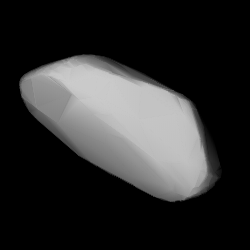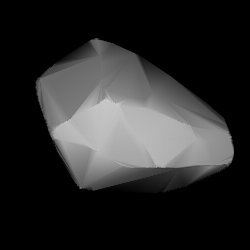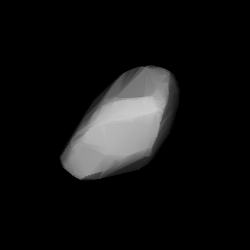Related Research Articles
779 Nina is a large background asteroid, approximately 80 kilometers in diameter, located in the central region of the asteroid belt. It was discovered on 25 January 1914, by Russian astronomer Grigory Neujmin(1886-1946) at the Simeiz Observatory on the Crimean peninsula. The metallic X-type asteroid with an intermediate albedo has a rotation period of 11.2 hours. It was named after the discoverer's sister, Nina Neujmina (Tsentilovich) (1889–1971).
917 Lyka is a background asteroid, approximately 32 kilometers in diameter, located in the inner region of the asteroid belt. It was discovered on 5 September 1915, by Russian astronomer Grigory Neujmin at the Simeiz Observatory on the Crimean peninsula. The X-type asteroid has a rotation period of 7.9 hours and is likely spherical in shape. It was named after Lyka, a friend of the discoverer's sister.

1030 Vitja, provisional designation 1924 RQ, is a dark background asteroid from the outer regions of the asteroid belt, approximately 60 kilometers in diameter. It was discovered on 25 May 1924, by Soviet–Russian astronomer Vladimir Albitsky at the Simeiz Observatory on the Crimean peninsula. The asteroid was named in honor of Viktor Zaslavskij (1925–1944), a relative of the discoverer.

1042 Amazone, provisional designation 1925 HA, is a dark asteroid and slow rotator in the outer asteroid belt, approximately 70 kilometers in diameter. It was discovered on 22 April 1925, by German astronomer Karl Reinmuth at Heidelberg Observatory in southern Germany. It is named after the Amazons from Greek mythology.
1043 Beate, provisional designation 1925 HB, is a stony asteroid from the outer region of the asteroid belt, approximately 32 kilometers in diameter. It was discovered by German astronomer Karl Reinmuth at the Heidelberg-Königstuhl State Observatory on 22 April 1925. Any reference of its name to a person is unknown.

1075 Helina, provisional designation 1926 SC, is a stony Eos asteroid from the outer regions of the asteroid belt, approximately 34 kilometers in diameter. It was discovered on 29 September 1926, by astronomer Grigory Neujmin at the Simeiz Observatory on the Crimean peninsula. The asteroid was named after the discoverer's son, Helij Neujmin.
1123 Shapleya, provisional designation 1928 ST, is a stony Florian asteroid from the inner regions of the asteroid belt, approximately 11 kilometers in diameter. It was discovered on 21 September 1928, by Russian astronomer Grigory Neujmin at Simeiz Observatory on the Crimean peninsula. It was named after American astronomer Harlow Shapley.
1124 Stroobantia, provisional designation 1928 TB, is a metallic asteroid from the outer region of the asteroid belt, approximately 25 kilometers in diameter. It was discovered on 6 October 1928, by Belgian astronomer Eugène Delporte at Uccle Observatory in Belgium. It is named for astronomer Paul Stroobant.

1137 Raïssa is a stony background asteroid and slow rotator, approximately 22 kilometers in diameter, located in the inner regions of the asteroid belt. It was discovered by Grigory Neujmin at Simeiz Observatory in 1929, and named in memory of Raïssa Maseeva, who worked at the Pulkovo Observatory.

1140 Crimea, provisional designation 1929 YC, is a stony asteroid from the middle region of the asteroid belt, approximately 28 kilometers in diameter. It was discovered on 30 December 1929, by Soviet astronomer Grigory Neujmin at Simeiz Observatory on the Crimean peninsula, after which it was named.
1146 Biarmia, provisional designation 1929 JF, is a metallic background asteroid from the outer regions of the asteroid belt, approximately 32 kilometers in diameter. It was discovered on 7 May 1929, by Russian astronomer Grigory Neujmin at the Simeiz Observatory on the Crimean peninsula. The asteroid was named for the Bjarmaland mentioned in Norse sagas.
1609 Brenda, provisional designation 1951 NL, is a stony asteroid from the central region of the asteroid belt, approximately 28 kilometers in diameter. It was discovered on 10 July 1951, by South African astronomer Ernest Johnson at the Johannesburg Observatory in South Africa, and named after his granddaughter, Brenda.
1347 Patria, provisional designation 1931 VW, is a carbonaceous asteroid from the background population of the central asteroid belt, approximately 32 kilometers in diameter. It was discovered on 6 November 1931, by Soviet astronomer Grigory Neujmin at the Simeiz Observatory on the Crimean peninsula. The asteroid was named for the Latin word of fatherland.
1266 Tone is a dark background asteroid from the outer regions of the asteroid belt, approximately 80 kilometers in diameter. Discovered by astronomer Okuro Oikawa at the Tokyo Observatory in 1927, it was assigned the provisional designation 1927 BD. The asteroid was later named after the Tone River, one of Japan's largest rivers.

1940 Whipple is a carbonaceous background asteroid from the outer region of the asteroid belt, approximately 35 kilometers in diameter. It was discovered on 2 February 1975, by the Harvard College Observatory at its George R. Agassiz Station near Harvard, Massachusetts, in the United States, and named after astronomer Fred Whipple.
1734 Zhongolovich, provisional designation 1928 TJ, is a carbonaceous Dorian asteroid from the central region of the asteroid belt, approximately 28 kilometers in diameter.

1339 Désagneauxa, provisional designation 1934 XB, is a stony Eoan asteroid from the outer region of the asteroid belt, approximately 24 kilometers in diameter. It was discovered on 4 December 1934, by French astronomer Louis Boyer at the North African Algiers Observatory in Algeria. A few nights later, the asteroid was independently discovered by astronomers Grigory Neujmin and Eugène Delporte, at the Crimean Simeiz and Belgian Uccle Observatory, respectively. It was later named after discoverer's brother-in-law.

1289 Kutaïssi is a stony Koronian asteroid from the outer region of the asteroid belt. Discovered by Grigory Neujmin at Simeiz Observatory in 1933, it was later named after the Georgian city of Kutaisi. The S-type asteroid has a rotation period of 3.6 hours and measures approximately 22 kilometers in diameter.
1461 Jean-Jacques, provisional designation 1937 YL, is a metallic asteroid from the outer region of the asteroid belt, approximately 34 kilometers in diameter. It was discovered on 30 December 1937, by French astronomer Marguerite Laugier at Nice Observatory in southern France, who named it after her son Jean-Jacques Laugier.
1481 Tübingia, provisional designation 1938 DR, is a dark asteroid from the outer region of the asteroid belt, approximately 34 kilometers in diameter. It was discovered on 7 February 1938, by German astronomer Karl Reinmuth at Heidelberg Observatory in southern Germany, and named for the German city of Tübingen.
References
- 1 2 3 4 "JPL Small-Body Database Browser: 1158 Luda (1929 QF)" (2017-01-07 last obs.). Jet Propulsion Laboratory . Retrieved 25 January 2017.
- 1 2 3 4 Schmadel, Lutz D. (2007). "(1158) Luda". Dictionary of Minor Planet Names – (1158) Luda. Springer Berlin Heidelberg. p. 98. doi:10.1007/978-3-540-29925-7_1159. ISBN 978-3-540-00238-3.
- 1 2 3 4 Alvarez-Candal, Alvaro; Duffard, René; Angeli, Cláudia A.; Lazzaro, Daniela; Fernández, Silvia (December 2004). "Rotational lightcurves of asteroids belonging to families". Icarus. 172 (2): 388–401. Bibcode:2004Icar..172..388A. doi:10.1016/j.icarus.2004.06.008 . Retrieved 25 January 2017.
- 1 2 3 4 "LCDB Data for (1158) Luda". Asteroid Lightcurve Database (LCDB). Retrieved 25 January 2017.
- 1 2 3 Masiero, Joseph R.; Grav, T.; Mainzer, A. K.; Nugent, C. R.; Bauer, J. M.; Stevenson, R.; et al. (August 2014). "Main-belt Asteroids with WISE/NEOWISE: Near-infrared Albedos". The Astrophysical Journal. 791 (2): 11. arXiv: 1406.6645 . Bibcode:2014ApJ...791..121M. doi:10.1088/0004-637X/791/2/121. S2CID 119293330 . Retrieved 25 January 2017.
- 1 2 3 4 Usui, Fumihiko; Kuroda, Daisuke; Müller, Thomas G.; Hasegawa, Sunao; Ishiguro, Masateru; Ootsubo, Takafumi; et al. (October 2011). "Asteroid Catalog Using Akari: AKARI/IRC Mid-Infrared Asteroid Survey". Publications of the Astronomical Society of Japan. 63 (5): 1117–1138. Bibcode:2011PASJ...63.1117U. doi:10.1093/pasj/63.5.1117. (online, AcuA catalog p. 153)
- 1 2 3 4 Tedesco, E. F.; Noah, P. V.; Noah, M.; Price, S. D. (October 2004). "IRAS Minor Planet Survey V6.0". NASA Planetary Data System. 12: IRAS-A-FPA-3-RDR-IMPS-V6.0. Bibcode:2004PDSS...12.....T . Retrieved 22 October 2019.
- 1 2 3 4 Mainzer, A.; Grav, T.; Masiero, J.; Hand, E.; Bauer, J.; Tholen, D.; et al. (November 2011). "NEOWISE Studies of Spectrophotometrically Classified Asteroids: Preliminary Results". The Astrophysical Journal. 741 (2): 25. arXiv: 1109.6407 . Bibcode:2011ApJ...741...90M. doi:10.1088/0004-637X/741/2/90. S2CID 118700974.
- 1 2 Kim, M.-J.; Choi, Y.-J.; Moon, H.-K.; Byun, Y.-I.; Brosch, N.; Kaplan, M.; et al. (March 2014). "Rotational Properties of the Maria Asteroid Family". The Astronomical Journal. 147 (3): 15. arXiv: 1311.5318 . Bibcode:2014AJ....147...56K. doi:10.1088/0004-6256/147/3/56. S2CID 119256964 . Retrieved 25 January 2017.
- 1 2 Behrend, Raoul. "Asteroids and comets rotation curves – (1158) Luda". Geneva Observatory . Retrieved 25 January 2017.
- 1 2 Warner, Brian D. (January 2011). "Upon Further Review: III. An Examination of Previous Lightcurve Analysis from the Palmer Divide Observatory". The Minor Planet Bulletin. 38 (1): 21–23. Bibcode:2011MPBu...38...21W. ISSN 1052-8091 . Retrieved 25 January 2017.
- 1 2 Warner, Brian D. (September 2005). "Asteroid lightcurve analysis at the Palmer Divide Observatory - winter 2004-2005". The Minor Planet Bulletin. 32 (3): 54–58. Bibcode:2005MPBu...32...54W. ISSN 1052-8091 . Retrieved 25 January 2017.
- 1 2 3 Veres, Peter; Jedicke, Robert; Fitzsimmons, Alan; Denneau, Larry; Granvik, Mikael; Bolin, Bryce; et al. (November 2015). "Absolute magnitudes and slope parameters for 250,000 asteroids observed by Pan-STARRS PS1 - Preliminary results". Icarus. 261: 34–47. arXiv: 1506.00762 . Bibcode:2015Icar..261...34V. doi:10.1016/j.icarus.2015.08.007. S2CID 53493339 . Retrieved 25 January 2017.
- 1 2 "1158 Luda (1929 QF)". Minor Planet Center. Retrieved 25 January 2017.
- ↑ Schmadel, Lutz D. (1997). Dictionary of Minor Planet Names – Introduction, Source of Information. Springer Berlin Heidelberg. p. 16. ISBN 978-3-662-06617-1.